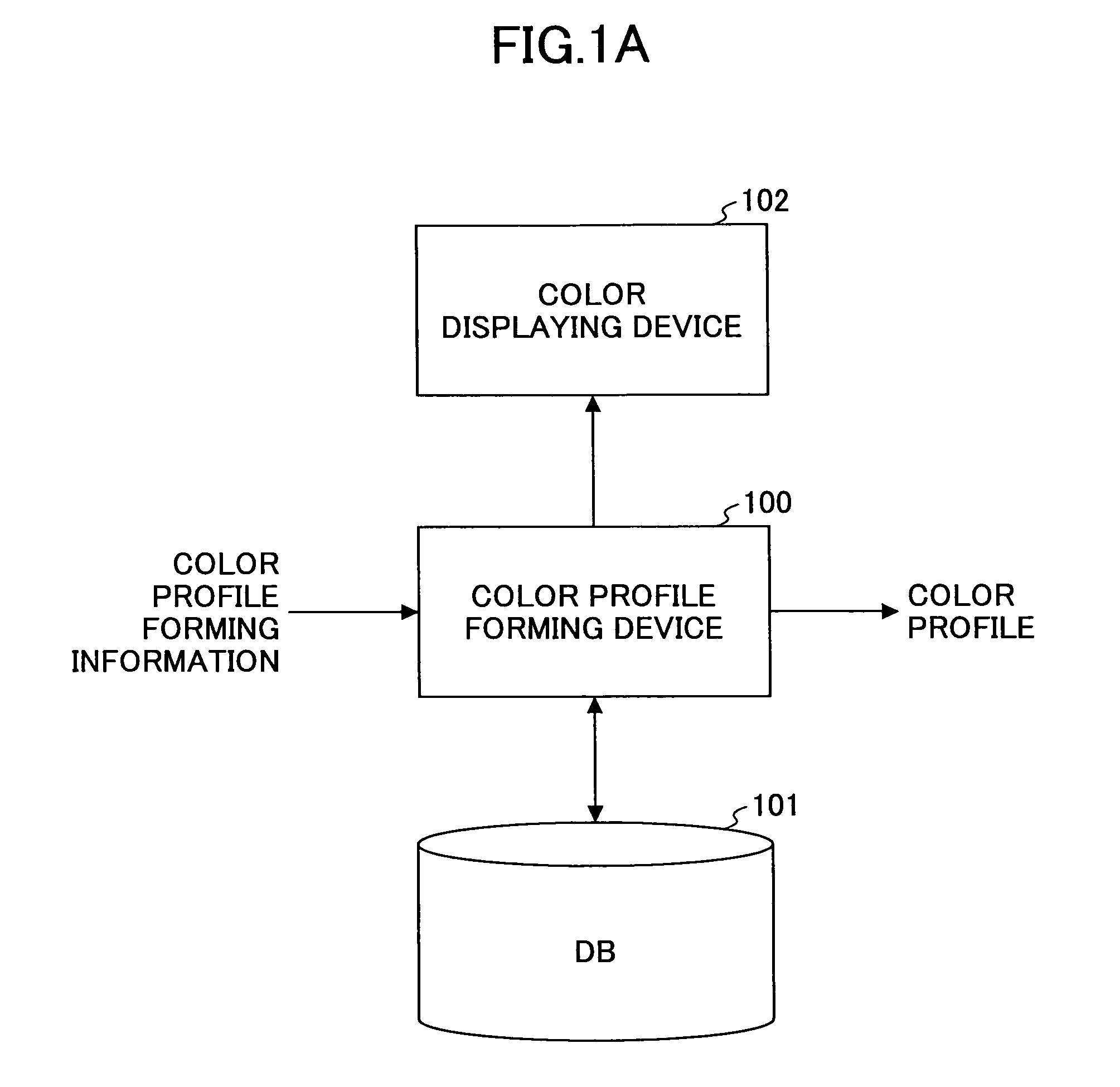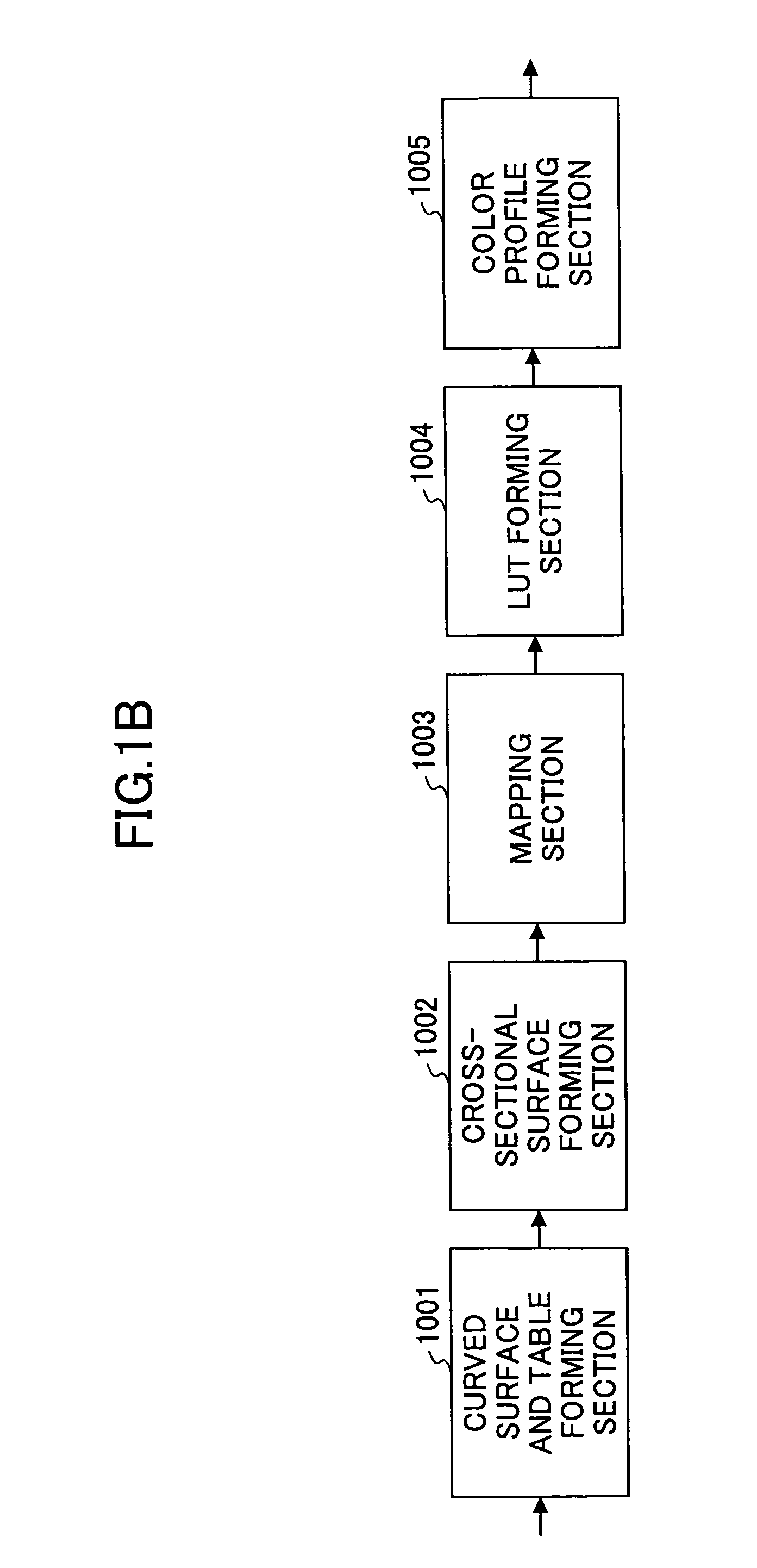Color gamut mapping by forming curved cross-sectional surfaces
a cross-sectional surface and color gamut technology, applied in the field of color gamut, can solve the problems of inability to obtain preference of gradation reproducibility, difficulty for users who are not experts, and may not be suitable for each user, and achieve the effect of high-quality color
- Summary
- Abstract
- Description
- Claims
- Application Information
AI Technical Summary
Benefits of technology
Problems solved by technology
Method used
Image
Examples
first embodiment
[0039]FIG. 1A is a block diagram showing an image processing apparatus according to a first embodiment of the present invention. As shown in FIG. 1A, the image processing apparatus includes a color profile forming device 100, a database (DB) 101, and a color displaying device 102. Color profile forming information such as a user preference color and a gamut mapping model is input to the color profile forming device 100 from input devices (not shown) such as a keyboard and a mouse. The color profile forming device 100 reads information from the DB 101 or records information in the DB 101, and further, sends an image and information to the color displaying device 102.
[0040]FIG. 1B is a block diagram showing the color profile forming device 100. As shown in FIG. 1B, the color profile forming device 100 includes a curved surface and table forming section 1001, a cross-sectional surface forming section 1002, a mapping section 1003, an LUT (lookup table) forming section 1004, and a color ...
second embodiment
[0107]When a user forms a color profile, since the color profile is formed based on a selection of an output image, adjacent curved surfaces may be overlapped. FIG. 15 is a diagram showing a state in which the adjacent curved surfaces are overlapped. In FIG. 15, an a*b* plane is shown in which a CIELAB color space is viewed from directly above.
[0108]Due to a curved surface generated by the plane 0 and the plane 1, a cross-sectional surface of the second gamut is shown as a bold line when the hue H=X. The cross-sectional surface includes a maximum chroma saturation point Cmax 1. A cross-sectional surface of a curved surface having a maximum chroma saturation point Cmax 2 adjacent to the hue H=X is shown as a broken bold line. A hatched part sandwiched between the cross-sectional surfaces is a hue overlapped part.
[0109]In the hue overlapped part, the magnitude relationship between hue angles is reversed. That is, the hue angle θ1 in the hue H=X becomes greater than the hue angle θ2 ad...
third embodiment
[0117]FIG. 18 is a diagram showing a hardware structure of an image processing system according to a third embodiment of the present invention. In the image processing system, the image processing method described above is realized by software.
[0118]The image processing system is realized by a computer, for example, a workstation or a personal computer. As shown in FIG. 18, a computer 10 includes a program reading device 10a, a CPU (central processing unit) 10b which controls all elements in the computer 10, a RAM 10c which is used as a work area of the CPU 10b and so on, a ROM 10d which stores a control program of the CPU 10a and so on, an HD (hard disk) 10e, an NIC (network interface card) 10f, a mouse 10g, and a keyboard 10h. The computer 10 is connected to a display 11 which displays image data and so on, and a printer 12 (image forming apparatus).
[0119]The color profile forming function described above can be realized by the CPU 10b. In addition, the DB 101 can be realized by t...
PUM
 Login to View More
Login to View More Abstract
Description
Claims
Application Information
 Login to View More
Login to View More - R&D
- Intellectual Property
- Life Sciences
- Materials
- Tech Scout
- Unparalleled Data Quality
- Higher Quality Content
- 60% Fewer Hallucinations
Browse by: Latest US Patents, China's latest patents, Technical Efficacy Thesaurus, Application Domain, Technology Topic, Popular Technical Reports.
© 2025 PatSnap. All rights reserved.Legal|Privacy policy|Modern Slavery Act Transparency Statement|Sitemap|About US| Contact US: help@patsnap.com



